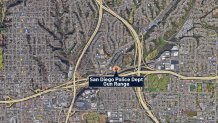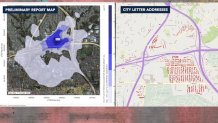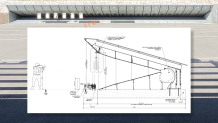Some San Diego families are demanding answers from the city, after learning they may have been exposed to lead dust from the police department’s gun range. That range is sandwiched in the triangle created by three main freeways, between Interstates 15 and 805, and north of Highway 94. Nearby neighborhoods include Mount Hope and Fairmount Park.

The city shut down the outdoor range on May 17, after more than a dozen police officers say their blood tested positive for elevated levels of lead.
At the time, Mayor Todd Gloria’s office told NBC 7 Investigates that the mayor immediately ordered a dust collection unit for the range and that the city planned to reopen the range with the new piece of equipment installed by October 2022.
NBC 7 Investigates started checking in on the status of the gun range in late September. We learned the range would remain closed indefinitely and the order for the dust collection unit was on hold. We also learned the city sent a letter to roughly 1,200 families who live near the range.
Dated Sept. 14, the letter informed recipients that the range had been shut down due to lead concerns. But the next three paragraphs aren’t even about the range. They focus on other ways people are exposed to lead, mostly focusing on hazards found in older homes.
NBC 7 Investigates went door-knocking, and the overwhelming majority of people we spoke with confused the letter for a public service announcement about lead-based paint and tossed it out.
“I would like to know more,” neighbor Meg O’Rourke told us. “I would definitely like to know more. Other than that letter, that’s the only notification that we’ve had [about why the range closed] and I have no idea where they are in that process.”
Neighbors also told us the letter didn’t make it clear their neighborhood was singled out, much less why.
“I don’t think it really explained anything,” Linda Mclean said. “Just that they closed.”
We asked the city for a list of addresses that received the letter and then mapped them out. We discovered those addresses lined up with maps from a preliminary Health Risk Assessment from the county’s Air Pollution Control District (the District).

The maps are a blueprint for areas the District believes the lead dust may have traveled to - increasing the risk for lead-induced cancer and lead exposure to children.
NBC 7 Investigates spoke with multiple experts with extensive backgrounds in toxicology and environmental sciences. That includes Dr. Howard Hu, who’s studied the health impacts of lead exposure for more than 30 years. He currently serves as the Chair and Professor of Population and Public Health Sciences at the Keck School of Medicine at the University of Southern California.
“The impact of lead on intelligence is real,” Dr. Hu said. “My major takeaway is, ‘Gosh, there was a potential for very significant exposure while the range was in operation.’”
Hu says hundreds of studies are clear: even small amounts of lead exposure increase rates of brain damage and attention deficit disorders in children, even in unborn children.
“Lead is an intergenerational risk if you will,” Hu said.
And Hu says that it’s the particles too small to see that spread the farthest when airborne and pose the greatest risk of getting inadvertently ingested weeks after the dust settles.
“I would be very concerned about ongoing surface contamination and children living in that environment,” Hu told NBC 7 Investigates.
“That’s very concerning,” Maclean said. “We have a lot of little kids in the neighborhood. A lot of us walking our dogs every day. So it’s very concerning for health reasons.”
Mayor Todd Gloria denied multiple requests for an interview. In a statement to NBC 7 Investigates, the mayor’s office told us, “The mayor has no intention of reopening an outdoor range at this site.”
The mayor’s office also says the city disagrees with the district’s risk assessment, telling us: “The City’s environmental experts have cast doubt on the validity of the HRA, because it’s based on a single sample that was run through what appears to be a faulty model to determine health risks to the community. Additional testing is necessary to properly evaluate these risks, and we are advocating for this additional examination to create a scientifically valid assessment of any health risks to residents. The sample size and modeling were insufficient to make this finding, and we therefore would like to independently verify the findings with a more scientifically rigorous method.”
A city spokeswoman told us the city wanted to reopen the range in order to collect new samples, but the District wouldn’t allow that. The District also told NBC 7 Investigates it stands by its report, saying it has enough information to support the fact that the health risk is there.
Hu says the best way to test the lead risk is to collect surface samples from neighborhoods surrounding the range to check how far the lead may have traveled, and how much has settled. That’s something the city says it has not done.
“Lead that’s deposited on surfaces and soil does not just disappear,” Hu said.
Hu also recommends neighboring parents test their kids’ blood lead levels. Something he says was woefully lacking from the city’s letter.
“They concentrated more on other sources of lead exposure, ironically,” Hu told us. “There’s nothing on actual health effects.”
The mayor’s office also told us, “The letter was drafted and sent prior to our receiving the draft health risk assessment by the APCD, and we strongly believe the science behind the HRA to be substandard. The City is being open and transparent with residents about known risks regarding lead exposure and the status of the gun range – and in fact is advocating for more rigorous testing in order to provide the most accurate assessment.”
However, NBC 7 Investigates has learned the Sept. 14 letter wasn’t the only one sent out.
In June, a letter signed by the mayor and council president was hand-delivered to about 600 homes near the range. But it, too, didn’t talk about any potential risk to the community.
“I feel like they didn’t give all the information,” Maclean said. “Kinda downplayed it.”
Back in Fairmount Park, neighbors we spoke with say the city has been anything but transparent.
“The more information you can provide the better,” Michael Boney said. “You provide the information to us and let us determine what to do with that information.”
“I think that’s important feedback,” City Council President Sean Elo-Rivera said. “We have an obligation to ensure that residents know what’s going on in their neighborhoods.”
Elo-Rivera says he wanted the gun range closed long before any lead concerns.
“I’ll be honest, I don't think a high-income, wealthy neighborhood would ever have to deal with the noise coming from that firing range,” Elo-Rivera told us. “And they wouldn’t put up with the noise coming from that firing range.”
Elo-Rivera also said he understood the confusion and concern in the wake of the letters and the District’s community risk report.
“If the feedback is that the way that the city is communicating is not actually comprehensible to the folks receiving that information, then it’s my job to advocate for better communication and I will do that,” Elo-Rivera said.
While the gun range has been around since the 1930s, the lead concerns didn’t start until May 2022, nearly a year after city renovations installed a new bullet trap system without the dust collection unit. That unit uses negative pressure to pull dust and toxins toward the back of the trap where it enters a filtering system.

Internal emails obtained by NBC 7 Investigates show a city official pushed to include the unit in the next phase of the renovation, but that phase had not started before the range was shut down. That dust collection unit would have cost $184,000 in addition to the total cost of the $17.8 million range renovation project.

Now, San Diego is shelling out $351,000 a year to rent space at another firing range to train its police force.
NBC 7 Investigates has spotted crews cleaning up the lead dust over the last several weeks. The city is working out a settlement with the Air Pollution Control District that could include monetary fines and additional cleanup. By state law, the city has three years to work that out.
A total of 14 worker compensation claims have been filed in connection with the range, according to a city spokeswoman.

